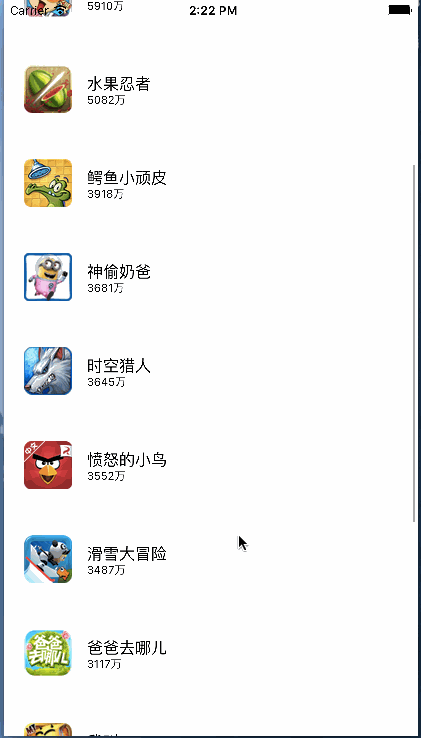IOS多线程实现多图片下载(一)
在没有步入正文之前先给大家展示下效果图,如果大家觉得很满意请继续往下阅读全文。
大家可以看到这个界面很简单,其实就是UITableView的布局,但是难点是在于如何从网上下载这些图片,下载之后应如何进行存储!
我们一步一步进行解析,先从单线程(主线程)进行多图片下载我们布局上的文字及图片的地址从plist文件中进行读取
根据结构,我们自定义一个数据模型文件
DDZApp.h
|
1
2
3
4
5
6
7
8
9
10
|
#
import
<Foundation/Foundation.h>
@interface
DDZApp : NSObject
//图标
@property
(nonatomic,strong) NSString *icon;
//名字
@property
(nonatomic,strong) NSString *name;
//下载量
@property
(nonatomic,strong) NSString *download;
+ (instancetype)appWithDict:(NSDictionary *)dict;
@end
|
DDZApp.m
|
1
2
3
4
5
6
7
8
|
#
import
"DDZApp.h"
@implementation
DDZApp
+ (instancetype)appWithDict:(NSDictionary *)dict {
DDZApp *app = [[self alloc] init];
[app setValuesForKeysWithDictionary:dict];
return
app;
}
@end
|
以下的都是视图控制器中的代码
ViewController.m
1.
|
1
2
3
4
5
6
|
@interface ViewController ()
//所有数据
@property (nonatomic,strong)NSArray *apps;
//内存缓存图片
@property (nonatomic,strong)NSMutableDictionary *imgCache;
@end
|
第一个属性用于存储读取plist文件中的内容,设置为属性保存起来,就可以不用重复读取
第二个属性用于保存从网上下载下来的图片,也是为了不用重复读取
2.
|
1
2
3
4
5
6
7
8
9
10
11
12
13
14
15
16
17
18
19
20
21
22
|
@implementation
ViewController
//读取数据
- (NSArray *)apps {
if
(!_apps) {
//从plist文件中读取数据
NSArray *dictArray = [NSArray arrayWithContentsOfFile:[[NSBundle mainBundle] pathForResource:@
"apps.plist"
ofType:nil]];
NSMutableArray *appArray = [NSMutableArray array];
for
(NSDictionary *dict in dictArray) {
[appArray addObject:[DDZApp appWithDict:dict]];
}
_apps = appArray;
}
return
_apps;
}
//缓存图片
- (NSMutableDictionary *)imgCache {
if
(!_imgCache) {
//初始化
_imgCache = [NSMutableDictionary dictionary];
}
return
_imgCache;
}
|
这两个方法都是为了初始化刚才的两个属性
3.
|
1
2
3
4
5
6
7
8
9
10
11
12
13
14
15
16
17
18
19
20
21
22
23
24
25
26
27
28
29
30
31
32
33
34
35
36
37
38
39
40
41
42
|
#pragma mark - 数据源方法
- (NSInteger)tableView:(UITableView *)tableView numberOfRowsInSection:(NSInteger)section {
return
self.apps.count;
}
- (UITableViewCell *)tableView:(UITableView *)tableView cellForRowAtIndexPath:(NSIndexPath *)indexPath {
static
NSString *ID = @
"app"
;
UITableViewCell *cell = [tableView dequeueReusableCellWithIdentifier:ID];
DDZApp *app = self.apps[indexPath.row];
cell.textLabel.text = app.name;
cell.detailTextLabel.text = app.download;
//先从内存中取出图片
UIImage *image = self.imgCache[app.icon];
if
(image) {
cell.imageView.image = image;
}
else
{
//内存中没有图片
//将图片文件数据写入到沙盒中
NSString *cachesPath = [NSSearchPathForDirectoriesInDomains(NSCachesDirectory, NSUserDomainMask, YES) firstObject];
//获得文件名
NSString *filename = [app.icon lastPathComponent];
//计算出文件的全路径
NSString *file = [cachesPath stringByAppendingPathComponent:filename];
//加载沙盒的文件数据
NSData *data = [NSData dataWithContentsOfFile:file];
//判断沙盒中是否有图片
if
(data) {
//直接加载沙盒中图片
cell.imageView.image = [UIImage imageWithData:data];
//存到字典(内存)中
self.imgCache[app.icon] = cell.imageView.image;
}
else
{
//下载图片
data = [NSData dataWithContentsOfURL:[NSURL URLWithString:app.icon]];
cell.imageView.image = [UIImage imageWithData:data];
//存到内存中
self.imgCache[app.icon] = cell.imageView.image;
//将图片数据写入到沙盒中
[data writeToFile:file atomically:YES];
}
}
return
cell;
}
|
这两个方法是UITableView必须要实现的方法
第一个是返回数据量,没什么好说的
第二个是绑定数据

